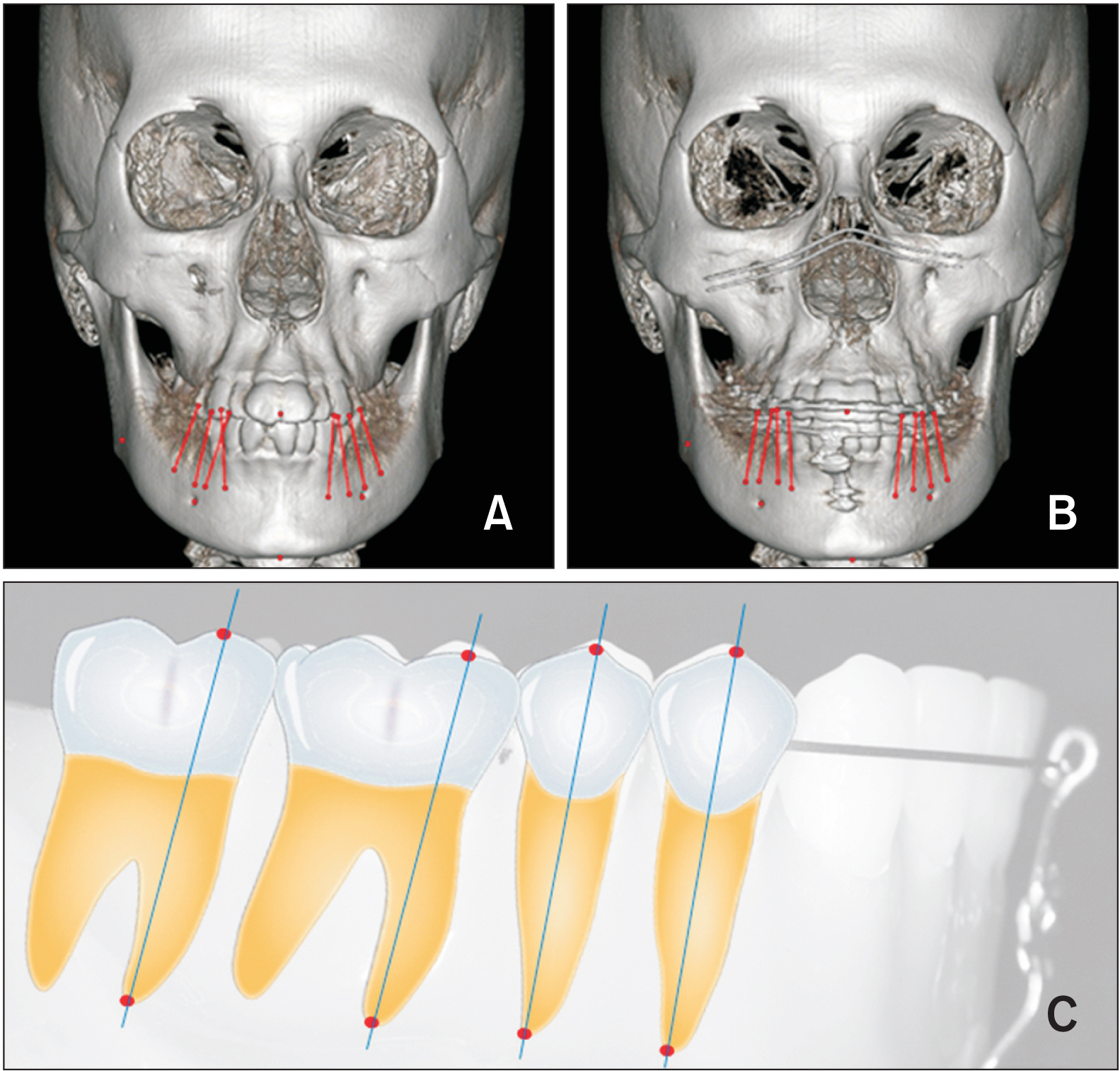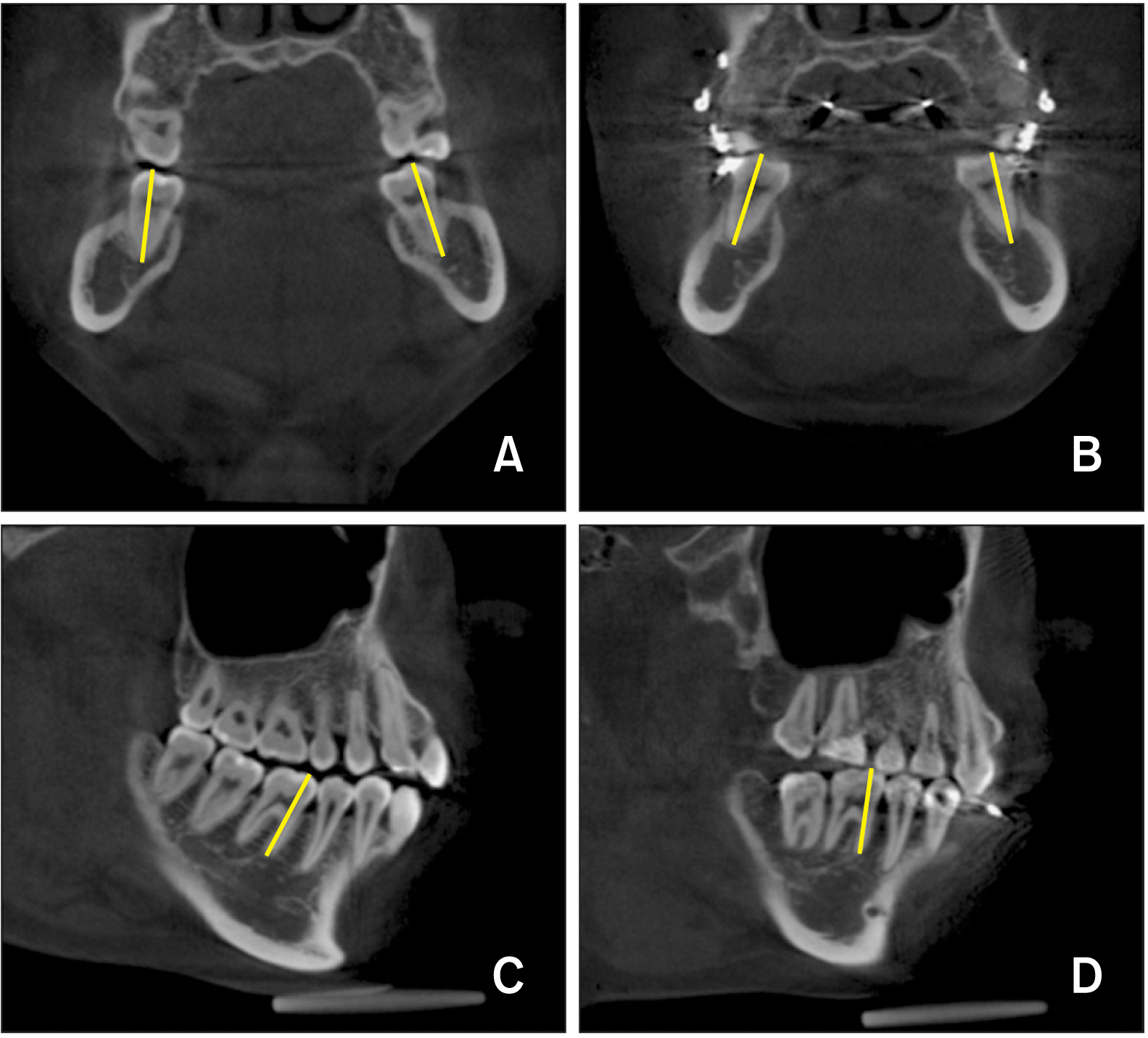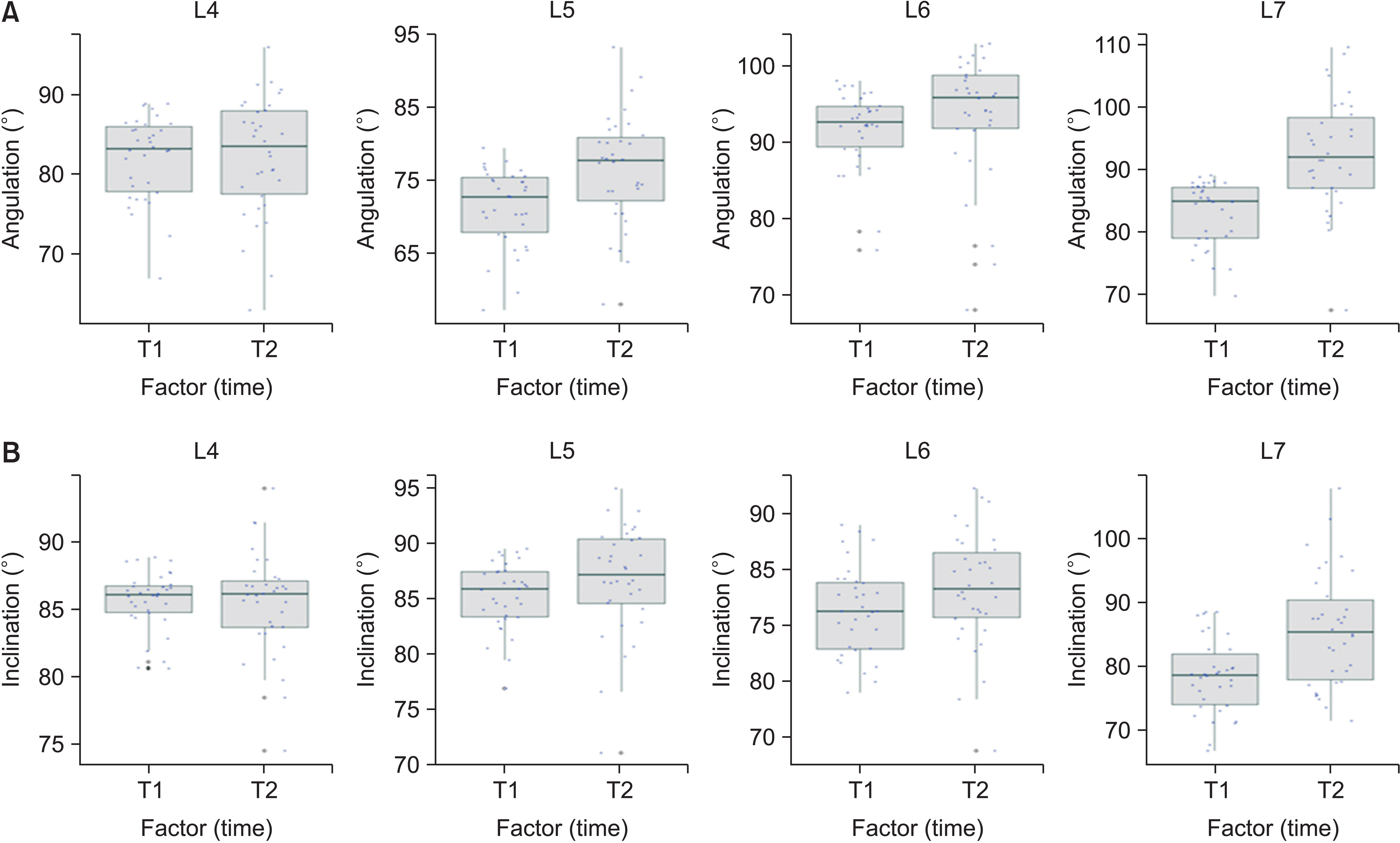Korean J Orthod.
2022 Sep;52(5):354-361. 10.4041/kjod22.140.
A cone-beam computed tomography study on strategic uprighting of mandibular molars using a biocreative reverse curve system
- Affiliations
-
- 1Department of Orthodontics, Graduate School, Kyung Hee University, Seoul, Korea
- KMID: 2533260
- DOI: http://doi.org/10.4041/kjod22.140
Abstract
Objective
To analyze the overall treatment effects in terms of the amount of uprighting with changes in the three-dimensional positions of the mandibular posterior teeth after applying the biocreative reverse curve (BRC) system.
Methods
Thirty-four patients (mean age, 20.5 ± 8.56 years) were treated using the BRC system (mean period, 8.17 ± 2.19 months). Cone-beam computed tomography was performed before treatment and after treatment with the BRC system. The three-dimensional movement of each tooth was analyzed in the coordinate system at points on the crown and root apex. A paired t-test was used to analyze the treatment effects of the BRC system.
Results
The application of the BRC system spanning from the first premolar to the second molar resulted not only in buccal and distal uprighting, but also in increased buccal and distal tipping of the teeth. The premolars and the first molar were extruded, and the second molar was intruded.
Conclusions
When the BRC system is applied, simultaneous distal and buccal uprighting of the premolars and molars can be achieved bilaterally using a temporary skeletal anchorage device without unnecessary movement of the anterior teeth.
Figure
Reference
-
1. Haralabakis NB, Tsianou A, Nicolopoulos C. 2003; Surgical correction of mesially impacted mandibular second molars. J Clin Orthod. 37:209–12. quiz 204PMID: 12747074.2. Staggers JA, Germane N, Fortson WM. 1992; A comparison of the effects of first premolar extractions on third molar angulation. Angle Orthod. 62:135–8. DOI: 10.1043/0003-3219(1992)062<0135:ACOTEO>2.0.CO;2. PMID: 1626747.3. Bernstein RL, Preston CB, Lampasso J. 2007; Leveling the curve of Spee with a continuous archwire technique: a long term cephalometric study. Am J Orthod Dentofacial Orthop. 131:363–71. DOI: 10.1016/j.ajodo.2005.05.056. PMID: 17346592. PMID: https://www.scopus.com/inward/record.uri?partnerID=HzOxMe3b&scp=33847360670&origin=inward.4. Alexander RG. 2011. The Alexander discipline: long-term stability. Quintessence Publishing Co., Inc.;Chicago: p. 141–3. DOI: 10.1016/j.ajodo.2005.05.056. PMID: https://www.scopus.com/inward/record.uri?partnerID=HzOxMe3b&scp=33847360670&origin=inward.5. Sawicka M, Racka-Pilszak B, Rosnowska-Mazurkiewicz A. 2007; Uprighting partially impacted permanent second molars. Angle Orthod. 77:148–54. DOI: 10.2319/010206-461R.1. PMID: 17029525. PMID: https://www.scopus.com/inward/record.uri?partnerID=HzOxMe3b&scp=33846107460&origin=inward.6. Shellhart WC, Oesterle LJ. 1999; Uprighting molars without extrusion. J Am Dent Assoc. 130:381–5. DOI: 10.14219/jada.archive.1999.0208. PMID: 10085661. PMID: https://www.scopus.com/inward/record.uri?partnerID=HzOxMe3b&scp=0033088964&origin=inward.7. Kim YH, Han UK. 2001; The versatility and effectiveness of the multiloop edgewise archwire (MEAW) in treatment of various malocclusions. World J Orthod. 2:208–18. PMID: https://www.scopus.com/inward/record.uri?partnerID=HzOxMe3b&scp=0026871955&origin=inward.8. Roberts WW 3rd, Chacker FM, Burstone CJ. 1982; A segmental approach to mandibular molar uprighting. Am J Orthod. 81:177–84. DOI: 10.1016/0002-9416(82)90051-3. PMID: 6960706. PMID: https://www.scopus.com/inward/record.uri?partnerID=HzOxMe3b&scp=0020103549&origin=inward.9. Lee KJ, Park YC, Hwang WS, Seong EH. 2007; Uprighting mandibular second molars with direct miniscrew anchorage. J Clin Orthod. 41:627–35. PMID: 18175884. PMID: https://www.scopus.com/inward/record.uri?partnerID=HzOxMe3b&scp=38549169728&origin=inward.10. Ahn HW, Noh MK, Chung KR, Kim SH, Nelson G. 2020; Strategic molar uprighting using the biocreative reverse-curve technique. J Clin Orthod. 54:486–94. PMID: 32966268. PMID: https://www.scopus.com/inward/record.uri?partnerID=HzOxMe3b&scp=85091547886&origin=inward.11. Ahn HW, Chung KR, Kang SM, Lin L, Nelson G, Kim SH. 2012; Correction of dental Class III with posterior open bite by simple biomechanics using an anterior C-tube miniplate. Korean J Orthod. 42:270–8. DOI: 10.4041/kjod.2012.42.5.270. PMID: 23173121. PMCID: PMC3495259. PMID: https://www.scopus.com/inward/record.uri?partnerID=HzOxMe3b&scp=84869031598&origin=inward.12. Park JH, Choo H, Choi JY, Chung KR, Kim SH. 2021; Evaluation of strategic uprighting of the mandibular molars using an orthodontic miniplate and a nickel-titanium reverse curve arch wire: preliminary cephalometric study. Korean J Orthod. 51:179–88. DOI: 10.4041/kjod.2021.51.3.179. PMID: 33984225. PMCID: PMC8133900. PMID: https://www.scopus.com/inward/record.uri?partnerID=HzOxMe3b&scp=85107188877&origin=inward.13. Burstone CJ, Koenig HA. 1988; Creative wire bending--the force system from step and V bends. Am J Orthod Dentofacial Orthop. 93:59–67. DOI: 10.1016/0889-5406(88)90194-1. PMID: 3422122. PMID: https://www.scopus.com/inward/record.uri?partnerID=HzOxMe3b&scp=0023675051&origin=inward.14. Burstone CJ, Koenig HA. 1974; Force systems from an ideal arch. Am J Orthod. 65:270–89. DOI: 10.1016/S0002-9416(74)90332-7. PMID: 4521361. PMID: https://www.scopus.com/inward/record.uri?partnerID=HzOxMe3b&scp=0016039755&origin=inward.15. Smith RJ, Burstone CJ. 1984; Mechanics of tooth movement. Am J Orthod. 85:294–307. DOI: 10.1016/0002-9416(84)90187-8. PMID: 6585147. PMID: https://www.scopus.com/inward/record.uri?partnerID=HzOxMe3b&scp=0021152639&origin=inward.
- Full Text Links
- Actions
-
Cited
- CITED
-
- Close
- Share
- Similar articles
-
- Evaluation of strategic uprighting of the mandibular molars using an orthodontic miniplate and a nickel-titanium reverse curve arch wire: Preliminary cephalometric study
- Assessment of the relationship between the mandibular third molar and the mandibular canal using panoramic radiograph and cone beam computed tomography
- Reliability of panoramic radiography in predicting proximity of third molars to the mandibular canal: A comparison using cone-beam computed tomography
- C-shaped root canal system in mandibular 2nd molars in Korean people evaluated by cone beam computed tomography
- Cone beam computed tomography findings of ectopic mandibular third molar in the mandibular condyle: report of a case







